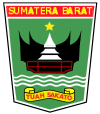West Sumatra
| West Sumatra Sumatra Barat | |||
|---|---|---|---|
| Province | |||
| Other transcription(s) | |||
| • Jawi | سومترا بارايق | ||
| • Minangkabau | Sumatera Baraik | ||
    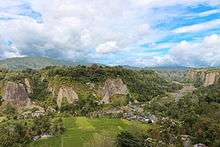   .jpg)    .jpg)    | |||
| |||
|
Motto(s): Tuah Sakato (Minangkabau) (United and Prosperous) | |||
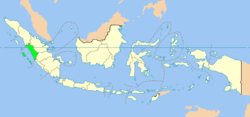 Location of West Sumatra (green) in Indonesia (beige). | |||
| Coordinates: 1°00′S 100°30′E / 1.000°S 100.500°ECoordinates: 1°00′S 100°30′E / 1.000°S 100.500°E | |||
| Country |
| ||
| Capital |
| ||
| Established | August 10, 1957 | ||
| Government | |||
| • Body | West Sumatra Regional Government | ||
| • Governor | Irwan Prayitno (PKS) | ||
| • Vice-governor | Nasrul Abit | ||
| Area | |||
| • Total | 42,012.89 km2 (16,221.27 sq mi) | ||
| Area rank | 16th | ||
| Highest elevation | 3,805 m (12,484 ft) | ||
| Lowest elevation | 0 m (0 ft) | ||
| Population (2017)[1] | |||
| • Total | 5,321,500 | ||
| • Rank | 11th | ||
| • Density | 130/km2 (330/sq mi) | ||
| • Density rank | 14th | ||
| Demonym(s) |
West Sumatran Warga Sumatera Barat (id) Urang Sumatera Baraik (min) | ||
| Demographics | |||
| • Ethnic groups | Minangkabau (88%), Batak (4%), Javanese (4%), Mentawai (1%), Other (3%)[2] | ||
| • Religion | Islam (97.4%), Christian (2.2%), Hindu (0.35%), Buddhism (0.06%) | ||
| • Languages |
Indonesian (official) Minangkabau, Mentawai (regional) | ||
| Time zone | UTC+7 (Indonesia Western Time) | ||
| Postcodes | 25xxx, 27xxx | ||
| Area codes | (62)75x | ||
| ISO 3166 code | ID-SB | ||
| Vehicle sign | BA | ||
| GRP per capita | US$ 2,741 | ||
| GRP rank | 19th | ||
| HDI |
| ||
| HDI rank | 9th (2016) | ||
| Largest city by area | Padang – 694.96 square kilometres (268.33 sq mi) | ||
| Largest city by population | Padang – (1,000,096 – 2014) | ||
| Largest regency by area | Mentawai Islands Regency – 6,011.35 square kilometres (2,321.00 sq mi) | ||
| Largest regency by population | Agam Regency – (472,995 – 2014) | ||
| Website | Government official site | ||
West Sumatra (Indonesian: Sumatera Barat, abbreviated to Sumbar, Jawi: سومترا بارايق, Minangkabau: Sumatera Baraik) is a province of Indonesia. It lies on the west coast of the island of Sumatra. The latest official estimate for January 2014 shows a population of 5,098,790. West Sumatra is sub-divided into 12 regencies and seven cities. It has relatively more cities than other provinces in Indonesia, except Java province.[3] Its capital is Padang.
It borders the provinces of North Sumatra (Sumatera Utara) to the north, Riau and Jambi to the east, and Bengkulu to the southeast. It includes the Mentawai Islands off the coast.
History
The history of West Sumatra is related to the history of the Minangkabau people. Archaeological evidence indicates that the area surrounding the Limapuluh Koto regency forms the first area inhabited by the Minangkabau. Limapuluh Koto regency covers a number of large rivers which meet at the eastern part of the Sumatran coastline and provided sailing transportation until the end of the last century. The Minangkabau ancestors were believed to have arrived via this route. They sailed from Asia (Indo-China) via the South China Sea, crossing the Malacca Strait and later settled along the Kampar, Siak and Indragiri (or Kuantan) rivers. Some lived and developed their culture and traits around the Limapuluh Koto regency.
The first westerner to reach West Sumatra was the French explorer Jean Parmentier in 1529. However, the westerners who came for economic and political reasons were the Dutch. The Dutch commercial fleet was seen along the southern coast of West Sumatra between 1595 and 1598. Apart from the Dutch, other European nationalities also came to the region such as the Portuguese and the English.
The integration with migrants in the ensuing periods introduced cultural changes and an increase in population. Their settlement area gradually became diminished and eventually they spread to other parts of West Sumatra. A portion of them went to the Agam regency while others went to the now Tanah Datar regency. From those areas onward, further spread of the population occurred north of the Agam regency, in particular, the Lubuk Sikaping. Rao and Ophir districts. Most of them settled in the western area such as the coastline and some in the southern parts in Solok, Selayo and the surrounding areas of Muara and Sijunjung.
The history of the West Sumatra Province became more accessible at the time of the rule by Adityawarman. This ruler left considerable amount of evidence of himself, although he did not proclaim that he was the Minangkabau King. Adityawarman ruled Pagaruyung, a region believed by the Minangkabau to be the center of its culture. Adityawarman was the most important figure in Minangkabau history. Apart from introducing a government system by a ruling monarch, he also contributed significantly to the Minangkabau world. His most important contribution was the spread of Buddhism. This religion had a very strong influence in the Minangkabau life. The evidence of such influence found in West Sumatra today includes names such as Saruaso, Pariangan, Padang Barhalo, Candi, Biaro, Sumpur and Selo.
Since the death of Adityawarman in the middle of the 17th century the history of West Sumatra seems more complex. During that time, the connection of West Sumatra with the outside world, in particular, Aceh, became more intense. West Sumatra at that time was the political dominion of Aceh which also monopolized the economy of the area. Coupled with the intensive connection Islam entered into West Sumatra. The new faith eventually became fundamental to the social and cultural way of life in the region. Sheik Burhanuddin was regarded as the first preacher of Islam in West Sumatra. Prior to expanding the faith in the region, he was studying in Aceh.
The dominating influence of Aceh's politics and economy did not make the people of western coast of Sumatra happy. Ultimately, the growing dissatisfaction gave way to the acceptance of the Dutch although the presence of them also opened up a new chapter in the history of West Sumatra. The arrival of the Dutch in the region caused them to enter the era of colonialism in the very of essence of its meaning, which cause another discontent in the region, particularly among the Islamists, which eventually led into an armed rebellion against the Dutch.
Geography
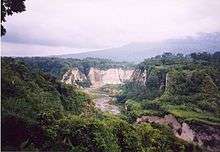
West Sumatra lies in the middle of the western coast of Sumatra, and has an area of 42,130.82 km2. Geographic features include plains, mountainous volcanic highlands formed by the Barisan mountain range that runs from north-west to south-east, and an offshore island archipelago called the Mentawai Islands. The West Sumatran coastline faces the Indian Ocean and stretches 375 km from North Sumatra province in the north-west to Bengkulu in the south-east. The lakes of West Sumatra include: Maninjau (99.5 km2), Singkarak (130.1 km2), Diatas (31.5 km2), Dibawah (14.0 km2), Talang (5.0 km2). The rivers of West Sumatra include: Kuranji, Anai, Ombilin, Suliki, Agam, Sinamar, Arau. The mountains & volcanoes of West Sumatra include: Kerinci (3,805 m), Marapi (2,891 m), Sago (2,271 m), Singgalang (2,877 m), Talakmau (2,912 m), Talang (2,572 m), Tandikat (2,438 m).
West Sumatra is one of the earthquake-prone areas in Indonesia, due to its location in the tectonic slab located between the confluence of two major continental plates (the Eurasian plate and Indo-Australian plate) and Great Sumatran fault,[4] plus the activity of the active volcanoes. Large earthquakes that occurred recently in West Sumatra earthquake were the 2009 Sumatra earthquake and the 2010 Mentawai earthquake and tsunami.
Flora and fauna
The province includes large areas of dense tropical forest, which is home to a host of species including: Rafflesia arnoldii (world's largest flower), Sumatran tiger, siamang, Malayan tapir, Sumatran serow, rusa deer, Malayan sun bear, Bornean clouded leopard, and many birds and butterflies.
The province includes two national parks: Siberut National Park and Kerinci Seblat National Park, as well as a number of nature reserves: Rimbo Panti Nature Reserve, Batang Palupuh Nature Reserve, Lembah Anai Nature Reserve, Lembah Harau Nature Reserve, Bung Hatta Grand Forest Park, and Beringin Sakti Nature Reserve.
Administrative divisions

West Sumatra Province is subdivided into twelve regencies and seven autonomous cities, which lie outside any regency. The regencies and cities are listed below with their areas and their populations at the 2010 Census and at the most recent (January 2014) estimates.
| Name | Area (km2) | Population Census 2010 | Population Estimate 2014 | Capital | HDI |
|---|---|---|---|---|---|
| Bukittinggi City | 25.24 | 110,954 | 117,097 | Bukittinggi | 0.780 (High) |
| Padang City | 694.96 | 833,584 | 954,880 | Padang | 0.798 (High) |
| Padang Panjang City | 23.00 | 47,008 | 49,451 | Padang Panjang | 0.750 (High) |
| Pariaman City | 73.36 | 79,073 | 83,151 | Pariaman | 0.746 (High) |
| Payakumbuh City | 80.43 | 116,910 | 122,896 | Payakumbuh | 0.764 (High) |
| Sawahlunto City | 273.45 | 56,812 | 59,821 | Sawahlunto | 0.696 (Medium) |
| Solok City | 57.64 | 59,317 | 62,483 | Solok | 0.762 (High) |
| Agam Regency | 2,232.30 | 455,484 | 478,490 | Lubuk Basung | 0.693 (Medium) |
| Dharmasraya Regency | 3,346.20 | 191,277 | 201,370 | Pulau Punjung | 0.692 (Medium) |
| Lima Puluh Kota Regency | 3,354.30 | 348,249 | 366,668 | Sarilamak | 0.667 (Medium) |
| Mentawai Islands Regency (Kepulauan Mentawai) | 6,011.35 | 76,421 | 80,131 | Tua Pejat | 0.567 (Low) |
| Padang Pariaman Regency | 1,328.79 | 390,204 | 411,378 | Parit Malintang | 0.675 (Medium) |
| Pasaman Regency | 3,947.63 | 252,981 | 266,462 | Lubuk Sikaping | 0.633 (Medium) |
| Sijunjung Regency | 2,745.73 | 188,317 | 201,627 | Muaro Sijunjung | 0.649 (Medium) |
| Solok Regency | 3,875.15 | 348,991 | 366,680 | Arosuka | 0.664 (Medium) |
| South Solok Regency (Solok Selatan) | 3,209.05 | 144,236 | 151,779 | Padang Aro | 0.662 (Medium) |
| South Pesisir Regency (Pesisir Selatan) | 5,794.95 | 429,699 | 451,553 | Painan | 0.677 (Medium) |
| Tanah Datar Regency | 1,336.60 | 338,584 | 356,085 | Batusangkar | 0.685 (Medium) |
| West Pasaman Regency (Pasaman Barat) | 3,887.77 | 364,587 | 384,104 | Simpang Ampek | 0.645 (Medium) |
As a new regency, Dharmasraya got the highest score (59.43) from a possible 100 among other new regencies.[5]
Before the reforms of 1999 and the implementation of regional autonomy in 2001, the lowest local government unit under the district administrations was the Javanese model of the village, the desa. Under regional autonomy, the traditional Minangkabau nagari, which are larger than villages elsewhere in Indonesia, have been reintroduced in place of the desa.[6][7]
Demographics
The Census population of West Sumatra was 2.8 million in 1971, 3.4 million in 1980, 4.0 million in 1990, 4.25 million in 2000, and 4.85 million in 2010,[8] the latter with 2,404,472 males and 2,442,437 females.[8] In 2014, West Sumatra's population was an estimated 5,098,790 people, of whom 4,486,935 (88%) were recorded by the Badan Pusat Statistik as Minangkabau people. Batak people, mainly from Mandailing sub-ethnic group, and Javanese comprised 4% of the population respectively, while Mentawai people who live in the Mentawai islands made up 1%.
| Historical population | ||
|---|---|---|
| Year | Pop. | ±% |
| 1971 | 2,793,176 | — |
| 1980 | 3,406,816 | +22.0% |
| 1990 | 4,000,207 | +17.4% |
| 2000 | 4,248,931 | +6.2% |
| 2010 | 4,846,909 | +14.1% |
| 2014 | 5,098,790 | +5.2% |
| 2017 | 5,321,500 | +4.4% |
| Source: Badan Pusat Statistik 2014 | ||
People

West Sumatra is the native homeland of Minangkabau people. They speak Minangkabau language and predominantly Muslim. West Sumatran have historically played the important role within the Muslim community in Indonesia.[10] Up until today the region is considered as one of the strongholds of Islam in Indonesia. They have a reputation as traders, intellectuals as well as politically savvy people who have successfully exported their culture, language, cuisine and beliefs throughout Indonesia.[11]
Mentawaians live on the Mentawai Islands, off the western coast of Sumatra, that are also part of the native people of province. They speak Mentawai languages, which are not intelligible with either Indonesian nor Minangkabau. Small minority of the Mentawais are Christians nowadays.
Urban areas
In 2015, about 44.2% of West Sumatran live in urban areas.[12] Most of the urban population of West Sumatra is concentrated in the centre-west coast of province and Minangkabau Highlands. West Sumatra has 3 cities with populations over 100,000. Padang is major metropolitan areas with the population of 1,000,096 in 2014. Minangkabau highlands cities of Payakumbuh and Bukittinggi rank as West Sumatra's next most populous cities, with populations of 127,826 and 117,097, respectively.
Education
Education is highly valued in the Minangkabau culture,[13] therefore West Sumatra was once a center of education on the island of Sumatra, especially in the education of Islam by mosque as the main base place.[14] During the colonial rule Islamic schools of education are so marginalized in comparison with the Dutch East Indies model which is considered more modern.[15] Since Islamic scholars sponsored many village schools, West Sumatra had one of the highest literacy rates in Indonesia.
West Sumatra is home to several universities, the most notable of which is Andalas University. It is the oldest university in Indonesia outside Java.
Sport
West Sumatra is also home of several professional soccer clubs. The most popular of them is Semen Padang, which regularly plays its matches in Haji Agus Salim Stadium, the biggest stadium in West Sumatra.
Tour de Singkarak, an annual road cycling race since 2009 is an official tournament series of Union Cycliste International (UCI). It covers more than 700 kilometers, from Padang passing around lake Singkarak and runs through inland West Sumatran cities. This sporting event is also meant to promote West Sumatra tourism.
Transport
.jpg)
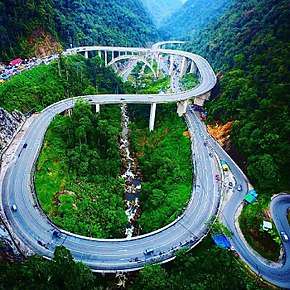
The province is served by Minangkabau International Airport, opened in July 2005, 23 km north-west of Padang in Ketaping, Padang Pariaman regency. The airport has direct international services to Kuala Lumpur in Malaysia, as well as servicing most large cities in Indonesia.
Significant roads include the Trans-Sumatran Highway which runs the length of the province, heading north-west towards Medan and south-east towards Jakarta, the road between Padang and Bukittinggi, and the road between Bukittinggi and Pekanbaru. The provincial government plans to upgrade the later two roads over the next few years to improve traffic flows.[16]
In January 2012, the Kelok Sembilan 970-meter long overpass was ready to be opened to the public and was in the trial stage which will be opened for vehicles in April 2012. Kelok Sembilan means 9 sharp turns is an area through which a road with tight bends passes through hilly terrain in the middle of a valley, a nice scenery, but cause congestion.[17] After the overpass opens, the old Kelok Sembilan road is still open together with the new Kelok Sembilan for tourists.
Regular bus services run between Padang and Bukittinggi, and the other major cities of Sumatra. Other public transport options within the province include train, oplet, taxi and horse cart (bendi).
Teluk Bayur port in Padang is the largest and busiest on the western coast of Sumatra. It is used for exporting goods from West Sumatra as well as from some areas of the neighboring provinces.
Railway services run between Padang and Pariaman city on weekends only and make a good day trip.
Tourism
The prime tourist attractions of West Sumatra are the natural environment, and the culture and history of the Minangkabau and Mentawai people.
Natural attractions of the mainland include the tropical forests, mountains, volcanos, lakes, valleys, rivers & waterfalls in the highlands, the fauna and flora, and the beaches around Padang. Many areas are protected as part of national parks and reserves. The city of Bukittinggi is a popular central location in the highlands from which to explore the culture and history of the Minangkabau people, including architecture, crafts, dances, music and food. There are a number of museums and cultural centers. Pariaman has one of the famous festivals, Tabuik. The Mentawai Islands are a popular destination for surfers and those looking to experience the culture and more primitive lifestyle of the Mentawai people. For developing West Sumatra tourism, in 2006 the government opened tourist train railway service run between Padang – Padang Panjang – Sawahlunto. The Tour de Singkarak international cycling race had boosted the number of the foreign tourists to West Sumatra.[18] The majority of the foreign tourists are Malaysians and Australian.
The favourite tourism places are :
- Jam Gadang – the clocktower in the downtown of Bukittinggi
- Panorama – Viewing to Sianok valley
- Air Manih beach – The beach that stretch from the north to south of Padang coastal
- Padang mountain
- Caroline beach
- Pagaruyung Palace in Batusangkar
- Harau valley
- Lake Maninjau
- Lake Singkarak
- Lake Diatas and Lake Dibawah
- Sikuai Island
There are 25 islands at Pesisir Selatan Regency potential to be tourist sites. Cubadak Island (9 hectares), Pagang Island (12 hectares) and Pulau Penyu (Turtle Island) have been developed well. At the northern part will be developed Semangki Besar Island, Semangki Kecil Island, Marak Island, Setan Terusan Island, and Karao Island. At the southern part will be developed Kerabak Ketek Island, Kerabak Gadang Island, and Kosong Island.[19]
The traditional dance is "Tari Piring" or Plate Dance which is originally came from Solok, West Sumatra.
Gallery
 Pagaruyung palace, since destroyed by fire
Pagaruyung palace, since destroyed by fire Street in central Padang
Street in central Padang
See also
References
- ↑ "Statistik Indonesia 2018". Badan Pusat Statistik. Retrieved July 24, 2018.
- ↑ Indonesia's Population: Ethnicity and Religion in a Changing Political Landscape. Institute of Southeast Asian Studies. 2003.
- ↑ Khee Giap Tan, Mulya Amri, Linda Low, Kong Yam Tan; Competitiveness Analysis and Development Strategies for 33 Indonesian Provinces, 2013
- ↑ Sieh, Kerry; Natawidjaja, Danny (December 10, 2000). "Neotectonics of the Sumatran fault, Indonesia" (PDF). Journal of Geophysical Research. 105 (B12): 28295–28326. doi:10.1029/2000JB900120.
- ↑ Indrasafitri, Dina; Sufa, Theresia (April 26, 2011). "Awards note progress in regional autonomy". The Jakarta Post. Archived from the original on April 27, 2011.
- ↑ Franz and Keebet von Benda-Beckmann, "Recentralization and Decentralization in West Sumatra," in Holtzappel and Ramstedt (eds.), Decentralization and Regional Autonomy in Indonesia: Implementation and Challenges, Singapore and Leiden, 2009, pp. 233ff. at 302.
- ↑ Sasdi, Ardimas (January 25, 2008). "West Sumatra reinvents its original roots". The Jakarta Post. Archived from the original on January 25, 2008.
- 1 2 "BPS: Jumlah Penduduk Sumbar 4.845.998 Orang" [BPS: The Population of West Sumatra is 4,845,998 People]. Metrotvnews.com. August 21, 2010. Archived from the original on November 27, 2010.
- ↑ "Population by Region and Religion in Indonesia". BPS. 2010.
- ↑ Giap, Tan Khee et al. Competitiveness Analysis And Development Strategies For 33 Indonesian Provinces. World Scientific.
- ↑ "West Sumatra". Lonely Planet. Retrieved February 28, 2017.
- ↑ BPS - Persentase Penduduk Daerah Perkotaan Menurut Provinsi 2010-2035
- ↑ Salim, Delmus Puneri, (2015), The Transnational and the Local in the Politics of Islam: The Case of West Sumatra, Springer International Publishing, ISBN 978-3-319-15413-8.
- ↑ Marsden, William, (2009), The History of Sumatra, BiblioBazaar, ISBN 978-0-559-09304-3.
- ↑ Arif Mahmud, (2008), Education Transformative Islam, PT Pelangi LKiS Literacy, ISBN 978-979-1283-40-3.
- ↑ Tularji (April 25, 2005). "6 Infrastructure projects to boost West Sumatra's rank". Bisnis Indonesia. Archived from the original on September 29, 2007.
- ↑ "Kelok Sembilan overpass set to open in April". The Jakarta Post. January 19, 2012. Archived from the original on May 22, 2013.
- ↑ "West Sumatra attracts 3,051 foreign tourists". Antara. August 4, 2011. Retrieved February 28, 2017.
- ↑ "25 Pulau di Pesisir Selatan Berpotensi sebagai Tempat Wisata". Media Indonesia. 30 May 2011. Archived from the original on June 2, 2011.
- "Statistics Indonesia – 2000 Population Statistics". Archived from the original on October 28, 2005. Retrieved December 26, 2005.
External links
| Wikivoyage has a travel guide for West Sumatra. |
| Wikimedia Commons has media related to West Sumatra. |
- Government website (in Indonesian)

